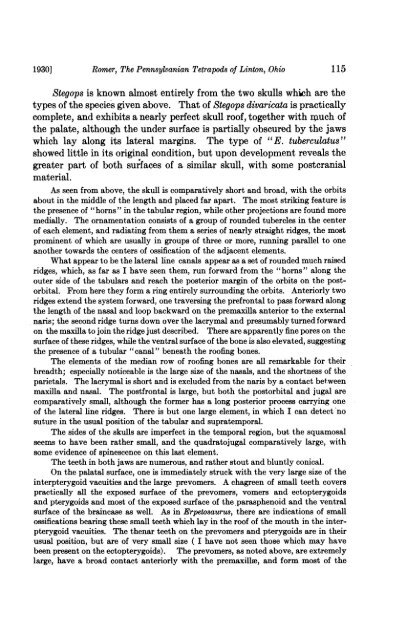View/Open - American Museum of Natural History
View/Open - American Museum of Natural History
View/Open - American Museum of Natural History
You also want an ePaper? Increase the reach of your titles
YUMPU automatically turns print PDFs into web optimized ePapers that Google loves.
1930] Romer, The Pennsylvanian Tetrapods <strong>of</strong> Linton, Ohio<br />
115<br />
Stegops is known almost entirely from the two skulls which are the<br />
types <strong>of</strong> the species given above. That <strong>of</strong> Stegops divaricata is practically<br />
complete, and exhibits a nearly perfect skull ro<strong>of</strong>, together with rpuch <strong>of</strong><br />
the palate, although the under surface is partially obscured by the jaws<br />
which lay along its lateral margins. The type <strong>of</strong> "E. tuberculatus"<br />
showed little in its original condition, but upon development reveals the<br />
greater part <strong>of</strong> both suifaces <strong>of</strong> a similar skull, with some postcranial<br />
material.<br />
As seen from above, the skull is comparatively short and broad, with the orbits<br />
about in the middle <strong>of</strong> the length and placed far apart. The most striking feature is<br />
the presence <strong>of</strong> "horns" in the tabular region, while other projections are found more<br />
medially. The ornamentation consists <strong>of</strong> a group <strong>of</strong> rounded tubercles in the center<br />
<strong>of</strong> each element, and radiating from them a series <strong>of</strong> nearly straight ridges, the most<br />
prominent <strong>of</strong> which are usually in groups <strong>of</strong> three or more, running parallel to one<br />
another towards the centers <strong>of</strong> ossification <strong>of</strong> the adjacent elements.<br />
What appear to be the lateral line canals appear as a set <strong>of</strong> rounded much raised<br />
ridges, which, as far as I have seen them, run forward from the "horns" along the<br />
outer side <strong>of</strong> the tabulars and reach the posterior margin <strong>of</strong> the orbits on the postorbital.<br />
From here they form a ring entirely surrounding the orbits. Anteriorly two<br />
ridges extend the system forward, one traversing the prefrontal to pass forward along<br />
the length <strong>of</strong> the nasal and loop backward on the premaxilla anterior to the external<br />
naris; the second ridge turns down over the lacrymal and presumably turned forward<br />
on the maxilla to join the ridge just described. There are apparently fine pores on the<br />
surface <strong>of</strong> these ridges, while the ventral surface <strong>of</strong> the bone is also elevated, suggesting<br />
the presence <strong>of</strong> a tubular "canal" beneath the ro<strong>of</strong>ing bones.<br />
The elements <strong>of</strong> the median row <strong>of</strong> ro<strong>of</strong>ing bones are all remarkable for their<br />
breadth; especially noticeable is the large size <strong>of</strong> the nasals, and the shortness <strong>of</strong> the<br />
parietals. The lacrymal is short and is excluded from the naris by a contact between<br />
maxilla and nasal. The postfrontal is large, but both the postorbital and jugal are<br />
comparatively small, although the former has a long posterior process carrying one<br />
<strong>of</strong> the lateral line ridges. There is but one large element, in which I can detect no<br />
suture in the usual position <strong>of</strong> the tabular and supratemporal.<br />
The sides <strong>of</strong> the skulls are imperfect in the temporal region, but the squamosal<br />
seems to have been rather small, and the quadratojugal comparatively large, with<br />
some evidence <strong>of</strong> spinescence on this last element.<br />
The teeth in both jaws are numerous, and rather stout and bluntly conical.<br />
On the palatal surface, one is immediately struck with the very large size <strong>of</strong> the<br />
interpterygoid vacuities and the large prevomers. A chagreen <strong>of</strong> small teeth covers<br />
practically all the exposed surface <strong>of</strong> the prevomers, vomers and ectopterygoids<br />
and pterygoids and most <strong>of</strong> the exposed surface <strong>of</strong> the parasphenoid and the ventral<br />
surface <strong>of</strong> the braincase as well. As in Erpetosaurus, there are indications <strong>of</strong> small<br />
ossifications bearing these small teeth which lay in the ro<strong>of</strong> <strong>of</strong> the mouth in the interpterygoid<br />
vacuities. The thenar teeth on the prevomers and pterygoids are in their<br />
usual position, but are <strong>of</strong> very small size ( I have not seen those which may have<br />
been present on the ectopterygoids). The prevomers, as noted above, are extremely<br />
large, have a broad contact anteriorly with the premaxille, and form most <strong>of</strong> the
















